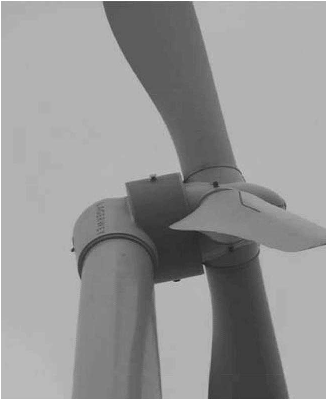




read more











Very important design aspects for which further work is needed are reliability and availability [ 20 ].
The phasecurrent is in the middle between the terminal voltage and the voltage induced by the magnets in order to reduce the saturation and to get a compromise between the converter rating and the generator rating.
The phase current leads the phase voltage a little in order to reduce saturation and excitation losses while a larger rating of the converter is not necessary.
Manufacturers supplying the DFIG3G use generator and converter components which are close to industrial standards yielding benefits in standardization, cost, and reliability.
With a gear ratio of 80, the rated speed of the generator is 1200 r/min, so that at rated speed, there is still some margin for control purposes.
The parameters of the second equivalent circuit can be calculated from the parameters of the first in the following way [15]:Ls = Lsσ + Lsm;RR = RrL2 sL2smLL = LsσLs Lsm + LrσL2 sL2sm . (15)To simplify the calculations, the second equivalent circuit has been used.
Using these characteristics, the available shaft power P can be calculated as a function of the wind speed as [2], [10]P = 1 2 ρairCp(λ, θ)πr2v3w (1)where ρair is the mass density of air, r is the wind turbine rotor radius, vw is the wind speed, and Cp(λ, θ) is the power coefficient or the aerodynamic efficiency, which is a function of the tip speed ratio λ (tip speed divided by wind speed) and the pitch angle θ.
The only commercially successful large direct-drive wind turbine manufacturer, Enercon, uses this system but they claim other benefits from the system.
The losses in the gearbox dominate the losses in this generator system: Roughly 70% of the annual energy dissipation in the generator system is in the gearbox.
The factor representing the reluctance of the iron of the magnetic circuit is calculated as [17]ksat = 1 + 1Hggeff ∫ lFe 0 HFedlFe (7)where HFe is the magnetic field intensity in the iron, estimated from the BH curve.
Because it is mainly built from standard components consisting of copper and iron, major improvements in performance or cost reductions cannot be expected.
The magnetizing current of this induction machine is rather large due to the considerable air gap and the high number of pole pairs.
Because the paper concentrates on the generator system, these numbers are not extensively validated and must be seen only as indicators.
In permanent-magnet machines, this factor representing saturation is much smaller than in the other machines because the effective air gap is much larger due to the low permeability of the magnets.
The annual energydissipation, determined from a combination of the losses with the Weibull distribution, is also depicted in Fig.
The annual energy dissipation, determined from a combination of the losses with the Weibull distribution, is also depicted in Fig. 13.
Iron losses are not negligible; at wind speeds up to 8 m/s, they are larger than the copper losses and over 15% of the annual dissipation in the generator system is in the iron.